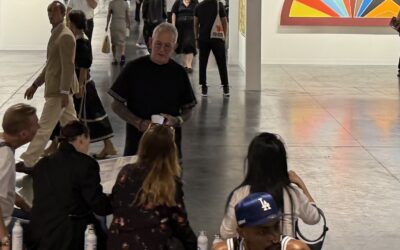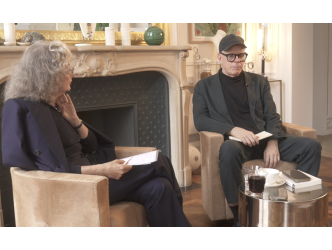Blum’s gallery sunset
On 1 July, a bombshell announcement shook the global art market. Blum, one of the most influential galleries in the United States—and more specifically Los Angeles—announced it was closing its doors. In describing this decision, Tim Blum chose his words carefully, speaking of “sunsetting the gallery.” The gallery, which is also established in Tokyo, represents several market heavyweights, including the Japanese superstar Yoshitomo Nara (born in 1959).
Nara
In both painting and sculpture,Nara has developed a cast of seemingly naïve characters that nevertheless carry a charge of violence or distress, and in fact serve as a reflection onsociety. (In 2019, a canvas he painted in 2000, “Knife Behind Back,” sold for $22.7 million, a record for the artist. And, despite the recent slowdown in the art market, as recently as 2025, one of his manga-inspired figures, the enigmatic “Cosmic Eyes,” was sold at auction in London for €10.9 million.
Tired of the art world system
“I am tired of the art world system in which I have been moving for the past 35 years,” Tim Blum confided. “Since 2009 it hasn’t stopped growing, always higher and always further. At the end of 2023, it changed radically. Those who won’t admit it are lying. The collecting public has undoubtedly diminished; the frenzy for art has vanished. In June at Art Basel Basel, there was no one visiting the stands, no exchange with visitors: Nothing.”
Allan Schwartzman
An observation which was announced by the well-known American private dealer Allan Schwartzman, who had remarked during Art Basel in Basel this year that “the market is tired”: squeezed on one side by long-time collectors who have reached saturation point in their acquisitions, and on the other by the lack of renewal, among younger generations, of the enthusiasm once felt for contemporary art.
Adam Lindemann
On July 11, Adam Lindemann, well-known New York dealer who is also a collector, notably of African art,declared to Artnet: “I am closing my gallery and going back to collecting.”
A few years ago, I interviewed him about the question of the right moment—about timing itself—in the art market.
Reimagining a fair
The United States is the leading country in art sales. But, in the same vein, on July 17 the ADAA (Art Dealers Association of America), which brings together more than 200 professionals across the country, discreetly announced it was putting on hold its October fair, The Art Show, at the Park Avenue Armory, in order to “reimagine the event.”
Clearing gallery bankruptcy
In the saga of the “collapse of the contemporary art system,” the most spectacular moment came at the very beginning of August, when the French dealer Olivier Babin, who had founded Clearing gallery in 2011 in New York and later Los Angeles, declared he was closing down the gallery. (Olivier Babin has decided not to make the video of the interview public).
Powerful energy with young artists
The gallery had injected a powerful energy into the very contemporary scene, supporting young talents such as the French sculptor Jean-Marie Appriou, the Thai artist Korakrit Arunanondchai- He primarily produces videos and installations- and the New York-based Belgian painter Harold Ancart, who has since risen to prominence and is now represented by Gagosian. (One of Ancart’s 2014 canvases, straddling abstraction and figuration, sold in 2016 for €700,000 against an estimate of €74,000, a record for the artist.)
The tradition of sugarcoating things
In Basel in June 2025, Olivier Babin organized a vast exhibition sale of 44 artists in a large house near the fair. “The worm had already gotten into the fruit. After returning from Basel, the writing was on the wall. It was time to call it quits. In fact, it had been difficult for two years. There is a tradition in our gallery community of lying, of sugarcoating things, because we need to inspire confidence, but sales were weak.”
America
“The art market is 50% American,” he continued, “and comes predominantly from New York. Thirty percent of clients even live on the Upper East Side.This is therefore a very New York problem, because rents there are exorbitant. And the situation will certainly not improve in the coming months. In Los Angeles, activity was impacted by the fires… There’s the ongoing war in Ukraine… Followed by another war… The American elections that everyone thought would bring improvement…”
New models?
It is easy to imagine that faced with such a decline in demand, the general level of prices in galleries but also at auction inevitably come down. Another consequence, in a weakened market, is the emergence of new models.
Laurent Godin
Paris gallerist Laurent Godin had been established in Paris since 2005. At a smaller scale, he shows, for example, the New York-based Mika Rottenberg (born in 1976), who creates sophisticated and intentionally absurd videos and is also represented by the multinational powerhouse Hauser & Wirth. At the beginning of July 2025, he deliberately downsized. He shut down his 1,000 square meters in the 13th arrondissement of Paris and opened a more modest space in Arles. An exemple of “degrowth” as the economists say.
Arles ecosystem
Thanks to the presence of professional collector Maja Hoffmann and her Luma Foundation, the capital of the Camargue region has indeed become a summer rallying point for the “avant-garde”, but for the rest of the year it remains a sleeping beauty( See here the last report about Arles). “The art market has become an industry. When I was a student, I entered it because I thought it was an ecosystem primarily concerned with art itself.” In Arles, Laurent Godin has taken on a far lower rent that does not require a frantic pace of transactions. In his inaugural exhibition presenting his roster of artists, works are priced between €1,000 and €80,000.
Jocelyn Wolff
In Paris, meanwhile, gallerist Jocelyn Wolff, going against the general trend, is opening a 400-square-meter space on rue de Penthièvre in the Élysée district, after operating for six years in the Paris suburb of Romainville. He explains: “It is possible to continue working well even as the market undergoes a major adjustment, by keeping a steadier rhythm than in the past.
Not billionnaires oriented
I believe the mistake galleries have made is to base their strategy primarily on purchases from billionaires. In Paris, we are fortunate to have many people from the upper middle classes who are prepared to spend small sums each year on art. They do not disappear when the market is in question.”
Miriam Cahn and Franz Erhard Walther
He is offering, for example, drawings by his leading artist, the Swiss painter Miriam Cahn (born in 1949), whose works are both brutal and powerful and often connected to current events (starting at €6,400for works on paper). The artist herself insists on keeping her prices accessible. The inaugural exhibition of Jocelyn Wolff’s new outfit, opening September 15, 2025, will be dedicated to the highly respected German conceptual artist Franz Erhard Walther (born in 1939): orks for sale starting at €8,000.
New Perspectives Art Partners
It was also over the summer that the announcement came of a new heavyweight group of art-market consultants, New Perspectives Art Partners. It brings together key art market figures of the past 30 years: Ed Dolman, who has just left the chairmanship of Phillips after having led the office of Sheikha Al-Mayassa Al Thani, the driving force behind the museums of Qatar; Brett Gorvy, co-founder of the Levy Gorvy gallery and former chairman of contemporary art at Christie’s; Patti Wong, art advisor in Hong Kong and former chairwoman of Sotheby’s Asia; and Alex Dolman, son of Ed, all associates of Philip Hoffman. Hoffman is the founder of the Fine Art Group, once focused on investment funds in art and now devoted to advising.
McKinsey style applied to art
“What is new in what we’re offering,” explains Philip Hoffman, the initiator of the venture, “is to act as consultants in a McKinsey style applied to art. In other words, these are five highly qualified people who can help you create a private museum, sell part of your collection, rethink it, or organize your children’s inheritance.
Auctions model
“The model of the auction houses as we know it is heavy, unwieldy,” he further explains. “You are dealing with the management of 1,500 employees. In our case, it is five people who wish to discreetly look after some of the 500 most important clients in the world, those who want to be superstars of collecting.” Philip Hoffman is not afraid of the current crisis: “The art market goes through cycles and I have already seen seven or eight of them. There is still a lot of liquidity available, and we are witnessing a change of taste among collectors. They are buying privately more and more, but also more slowly and more cautiously.”
New paradigm
The global art market is entering a new paradigm, the outlines of which are gradually taking shape. A redefinition of art and its actors is now underway.
(The interviews have been slightly edited for overall readability.)
Support independent news on art.
Your contribution : Make a monthly commitment to support JB Reports or a one-off contribution as and when you feel like it. Choose the option that suits you best.
Need to cancel a recurring donation? Please go here.
The donation is considered to be a subscription for a fee set by the donor and for a duration also set by the donor.




